Introductions¶
\imt#¶
- Syntax
\imt#_text...- Type
paragraph
- Added
1.0
- Use
Introduction major title.
The variable # denotes the title level or relative weighting.
\imt = \imt1 (see syntax notes on numbered markers)
 Recommended use is for the introduction title or other major introduction division (rather than \is) when the introduction text contains numerous additional sub-divisions.
Recommended use is for the introduction title or other major introduction division (rather than \is) when the introduction text contains numerous additional sub-divisions.
Text and Formatting Sample - Introduction to Mark (RVE)
\h SAN MARCOS
\mt2 Evangelio según
\mt1 SAN MARCOS
\imt1 INTRODUCCIÓN
\is1 Importancia del evangelio de Marcos
\ip Este evangelio, segundo de los libros del NT, contiene poco material que no aparezca
igualmente en \bk Mateo\bk* y \bk Lucas.\bk*
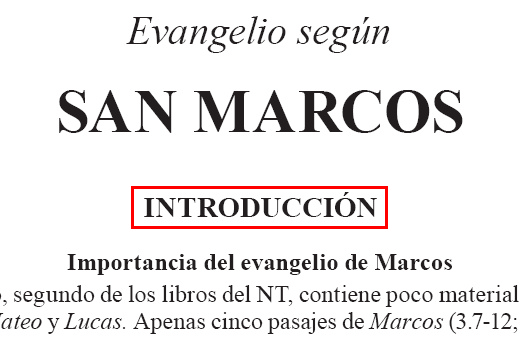
\is#¶
- Syntax
\is#_text...- Type
paragraph
- Added
1.0
- Use
Introduction section heading.
The variable # denotes the title level or relative weighting.
\is = \is1 (see syntax notes on numbered markers)
Text and Formatting Sample - Introduction to Mark (RVE)
\h SAN MARCOS
\mt2 Evangelio según
\mt1 SAN MARCOS
\imt1 INTRODUCCIÓN
\is1 Importancia del evangelio de Marcos
\ip Este evangelio, segundo de los libros del NT, contiene poco material que no aparezca
igualmente en \bk Mateo\bk* y \bk Lucas\bk*.
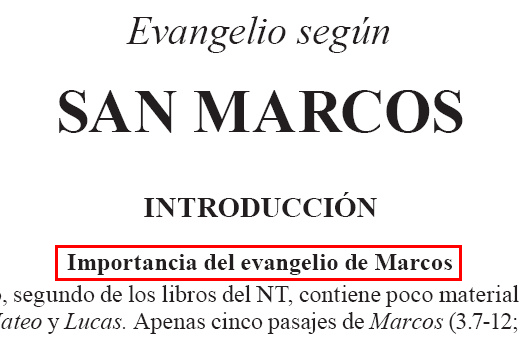
\ip¶
- Syntax
\ip_text...- Type
paragraph
- Added
1.0
- Use
Introduction paragraph.
Text and Formatting Sample - Introduction to Mark (GNT)
\h Mark
\mt2 The Gospel according to
\mt1 MARK
\is Introduction
\ip \bk The Gospel according to Mark\bk* begins with the statement that it is “the Good News
about Jesus Christ, the Son of God.” Jesus is pictured as a man of action and authority. His
authority is seen in his teaching, in his power over demons, and in forgiving people's sins.
Jesus speaks of himself as the Son of Man, who came to give his life to set people free from sin.
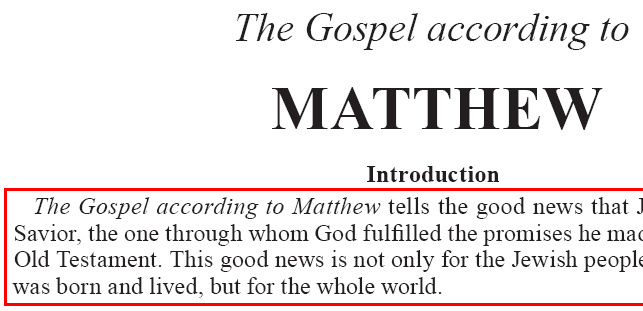
\ipi¶
- Syntax
\ipi_text...- Type
paragraph
- Added
1.0
- Use
Indented introduction paragraph.
Text and Formatting Sample - Introduction to the Deuterocanonicals/Apocrypha (GCEV)
\ip The following lists summarize each Christian tradition’s views of the books here designated
as Deuterocanonicals/Apocrypha.
\ipi Many Protestants consider the following books to be Apocrypha as defined above: Tobit,
Judith, additions to Esther (as found in Greek Esther in the CEV) ...
\ipi Roman Catholics consider the following books to be Deuterocanonical and of equal status
with all other books of the Old Testament: Tobit, Judith, Greek Esther ...
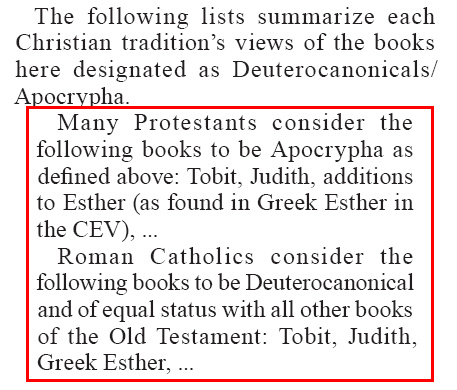
\im¶
- Syntax
\im_text...- Type
paragraph
- Added
1.0
- Use
Introduction flush left (margin) paragraph.
Text and Formatting Sample - Introduction to the GCEV
\imt1 Preface:
\is1 A Word about the Contemporary English Version
\imi \em Translation it is that opens the window, to let in the light; that breaks the shell,
that we may eat the kernel; that puts aside the curtain, that we may look into the most holy place;
that removes the cover of the well, that we may come by the water.\em* (“The Translators to the
Reader,” King James Version, 1611).
\im The most important document in the history of the English language is the \bk King James
Version\bk* of the Bible...
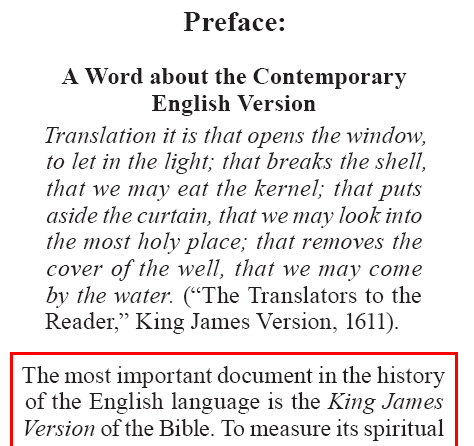
\imi¶
- Syntax
\imi_text...- Type
paragraph
- Added
1.0
- Use
Indented introduction flush left (margin) paragraph.
Text and Formatting Sample - Introduction to the GCEV
\imt1 Preface:
\is1 A Word about the Contemporary English Version
\imi \em Translation it is that opens the window, to let in the light; that breaks the shell,
that we may eat the kernel; that puts aside the curtain, that we may look into the most holy place;
that removes the cover of the well, that we may come by the water.\em* (“The Translators to the
Reader,” King James Version, 1611).
\im The most important document in the history of the English language is the \bk King James
Version\bk* of the Bible...
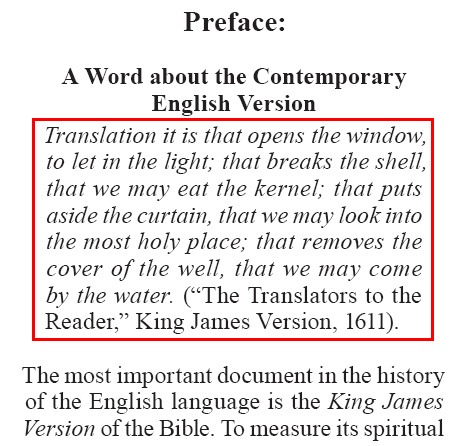
\ipq¶
- Syntax
\ipq_text...- Type
paragraph
- Added
1.0
- Use
Introduction quote from text paragraph.
Text and Formatting Sample - Introduction to Genesis (CEV)
... One of these brothers, Joseph, had become the governor of Egypt. But Joseph knew that
God would someday keep his promise to his people:
\ib
\ipq Before Joseph died, he told his brothers, “I won't live much longer. But God will take
care of you and lead you out of Egypt to the land he promised Abraham, Isaac, and Jacob.”
\ipr (50.24)
\iot A QUICK LOOK AT THIS BOOK
...
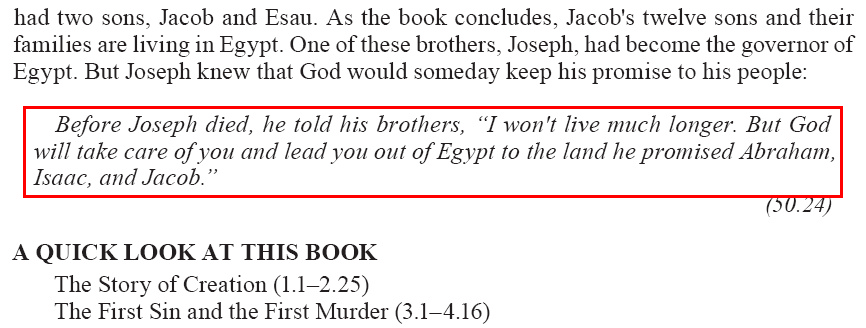
\imq¶
- Syntax
\imq_text...- Type
paragraph
- Added
1.0
- Use
Introduction flush left (margin) quote from text paragraph.
Text and Formatting Sample - Introduction to Genesis (CEV)
... One of these brothers, Joseph, had become the governor of Egypt. But Joseph knew that
God would someday keep his promise to his people:
\ib
\imq Before Joseph died, he told his brothers, “I won't live much longer. But God will take
care of you and lead you out of Egypt to the land he promised Abraham, Isaac, and Jacob.”
\ipr (50.24)
\iot A QUICK LOOK AT THIS BOOK
...
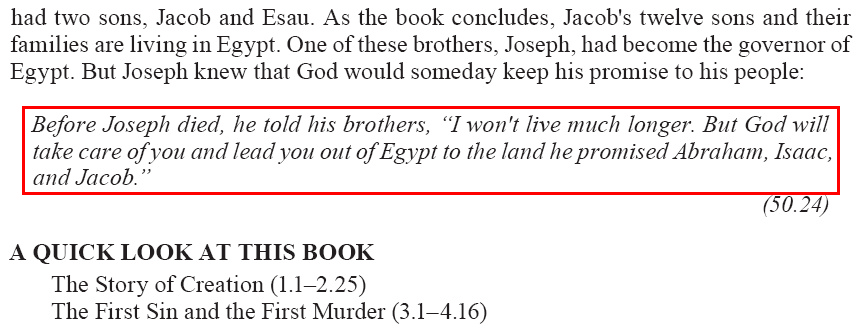
\ipr¶
- Syntax
\ipr_text...- Type
paragraph
- Added
1.0
- Use
Introduction right-aligned paragraph.
Typically used for a quote from text reference.
Text and Formatting Sample - Introduction to Genesis (CEV)
... One of these brothers, Joseph, had become the governor of Egypt. But Joseph knew that
God would someday keep his promise to his people:
\ib
\ipq Before Joseph died, he told his brothers, “I won't live much longer. But God will take
care of you and lead you out of Egypt to the land he promised Abraham, Isaac, and Jacob.”
\ipr (50.24)
\iot A QUICK LOOK AT THIS BOOK
...
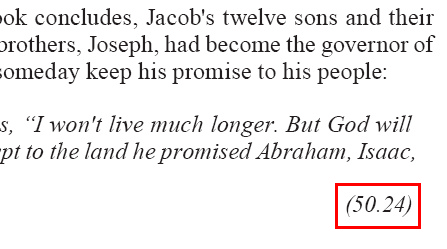
\iq#¶
- Syntax
\iq#_text...- Type
paragraph
- Added
1.0
- Use
Introduction poetic line.
The variable # represents the indent level (i.e. iq1, iq2, iq3 etc.)
\iq = \iq1 (see syntax notes on numbered markers)
Text and Formatting Sample - Introduction to Titus (CEV)
\ip Paul also tells how we are saved:
\ib
\iq1 God our Savior showed us
\iq2 how good and kind he is.
\iq1 He saved us because
\iq2 of his mercy,
\iq1 and not because
\iq2 of any good things
\iq2 that we have done.
\ipr (3.4,5a)
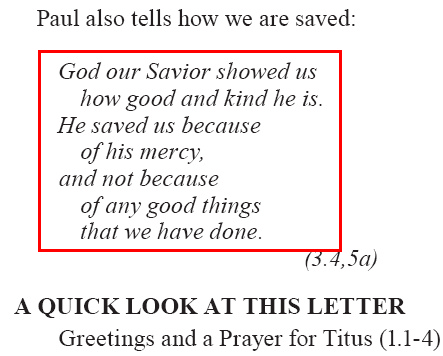
\ib¶
- Syntax
\ib- Type
paragraph
- Added
1.0
- Use
Introduction blank line.
May be used to explicitly indicate additional white space between paragraphs.
Text and Formatting Sample - Introduction to Genesis (CEV)
... One of these brothers, Joseph, had become the governor of Egypt. But Joseph knew that
God would someday keep his promise to his people:
\ib
\imq Before Joseph died, he told his brothers, “I won't live much longer. But God will take
care of you and lead you out of Egypt to the land he promised Abraham, Isaac, and Jacob.”
![]() See also \ipq, \imq examples (above).
See also \ipq, \imq examples (above).
\ili#¶
- Syntax
\ili#_text...- Type
paragraph
- Added
1.0
- Use
Introduction list item.
The variable # represents the level of indent.
\ili = \ili1 (see syntax notes on numbered markers)
Text and Formatting Sample - Introduction to Mark (Good News Study Bible)
\ip However, he is more than a teacher, healer, or \w miracle\w*-worker. He is also the
Messiah, the Son of God, the Son of Man. These three titles express the first Christians'
understanding of who Jesus is.
\ili 1 \k The Messiah\k* is the one promised by God, the one who would come and free God's
people. By the time \bk The Gospel of Mark\bk* appeared, the title "Messiah" (in Greek,
"\w christ\w*") had become a proper name, so that the Gospel opens with "the Good News about
Jesus Christ" (and not "Jesus the Christ"). Peter's confession (8.29) marks a turning-point
in the ministry of Jesus. The title "\w son of david\w* " (10.46-48) also identifies Jesus
as the Messiah, who would restore to Israel the power and glory it enjoyed under David's
reign (also 12.35-37).
\ili 2 \k The Son of God\k* is the title by which the heavenly voice addresses Jesus at his
baptism (1.11) and his transfiguration (9.7). And at Jesus' death the Roman officer confesses
that Jesus is the Son of God (15.39).
\ili 3 \k The Son of Man\k* is the title most often used of Jesus, and it appears only on the
lips of Jesus. This enigmatic title appears in \bk The Book of Daniel\bk* (Dan 7.13n), where
it is applied to the exalted figure to whom God gives universal dominion. In \bk Mark\bk* the
title is used of Jesus in three ways: the Son of Man acts with divine power (2.10, 28); he will
be rejected, will suffer and die (8.31; 9.9, 12, 31; 10.33-34, 45; 14.21, 41); he will return
in power and glory (8.38; 13.26; 14.62).
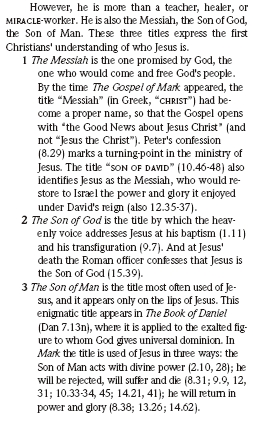
\iot¶
- Syntax
\iot_text...- Type
paragraph
- Added
1.0
- Use
Introduction outline title.
\io#¶
- Syntax
\io#_text...(references range)- Type
paragraph
- Added
1.0
- Use
Introduction outline entry.
The outline entry typically ends with a range of references in parentheses. References may be marked with \ior …\ior*.
The variable # represents the outline (indent) level.
\io = \io1 (see syntax notes on numbered markers)
Text and Formatting Sample - Introduction to Mark (CEV)
\ip The two endings to the Gospel, which are enclosed in brackets, are generally regarded
as written by someone other than the author of \bk Mark\bk*
\iot Outline of Contents
\io1 The beginning of the gospel (1.1-13)
\io1 Jesus' public ministry in Galilee (1.14–9.50)
\io1 From Galilee to Jerusalem (10.1-52)
\io1 The last week in and near Jerusalem (11.1–15.47)
\io1 The resurrection of Jesus (16.1-8)
\io1 The appearances and ascension of the risen Lord (16.9-20)
\c 1
\s The Preaching of John the Baptist
\r (Matthew 3.1-12; Luke 3.1-18; John 1.19-28)
\p
\v 1 This is the Good News about Jesus Christ

\ior …\ior*¶
- Syntax
\ior_text...\ior*- Type
character
- Added
1.0
- Use
Introduction outline reference range.
An outline entry typically ends with a range of references in parentheses. This is an optional character style for marking (and potentially formatting) these references separately.
Text and Formatting Sample - Introduction to Mark (CEV)
\io1 The beginning of the gospel \ior (1.1-13)\ior*
\io1 Jesus' public ministry in Galilee \ior (1.14–9.50)\ior*
\io1 From Galilee to Jerusalem \ior (10.1-52)\ior*
\io1 The last week in and near Jerusalem \ior (11.1–15.47)\ior*
\io1 The resurrection of Jesus \ior (16.1-8)\ior*
\io1 The appearances and ascension of the risen Lord \ior (16.9-20)\ior*

\iqt …\iqt*¶
- Syntax
\iqt_text...\iqt*- Type
character
- Added
2.2
- Use
Introduction quoted text.
Scripture quotations, or other quoted text, appearing in the introduction.
\imte#¶
- Syntax
\imte#_text...- Type
paragraph
- Added
1.0
- Use
Introduction major title ending.
Used to mark a major title indicating the end of the introduction.
The variable # represents a portion of the title, with the lesser emphasis (relative weighting) being on the higher numbers.
\imte = \imte1 (see syntax notes on numbered markers)
Text and Formatting Sample - Introduction to Mark
\imte End of the Introduction to the Gospel of Mark
\ie¶
- Syntax
\ie- Type
paragraph
- Added
1.0
- Use
Introduction end.
Optionally included to explicitly indicate the end of the introduction material.
Text and Formatting Sample - Introduction to Mark (GNT)
\io1 The resurrection of Jesus (16.1-8)
\io1 The appearances and ascension of the risen Lord (16.9-20)
\ie
\c 1
\s The Preaching of John the Baptist
\r (Matthew 3.1-12; Luke 3.1-18; John 1.19-28)
\p
\v 1 This is the Good News about Jesus Christ